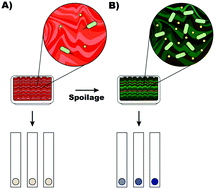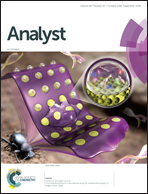Detection of bacterial contamination in food matrices by integration of quorum sensing in a paper-strip test†
Abstract
There are an estimated 48 million cases of foodborne illness in the United States every year. In general, these illnesses are the result of unintentional contamination and improper food handling. Because bacterial contamination plays a major role in food spoilage and, hence, in foodborne illnesses, it is important to design easy, portable methods to detect bacteria in food. Quorum sensing (QS) enables bacteria to communicate with one another and by doing so they can modulate their behavior in a cell-density dependent manner. In bacteria, quorum sensing molecules (QSMs) are known to control several factors such as virulence factor production, antibiotic production, biofilm formation, and gene regulation. Herein, we demonstrate the applicability of whole cell biosensing systems for the early identification of food contamination via detection of QSMs. Additionally, we have developed a portable system for detection of bacterial contamination using microdots of immobilized whole cell-based biosensors on paper that boast nanomolar level detection of QSMs in two different food matrices, namely beef and milk. Limits of detection ranged from 1 × 10−7 M to 1 × 10−9 M with relative standard deviations (RSDs) of 1–16%. This rapid, easy, and portable test could be a useful tool for use in the field and during all stages of food manipulation, i.e., from farms to distribution, storage, sales, and preparation prior to consumption, to ensure that food is free of bacterial contamination.



 Please wait while we load your content...
Please wait while we load your content...
